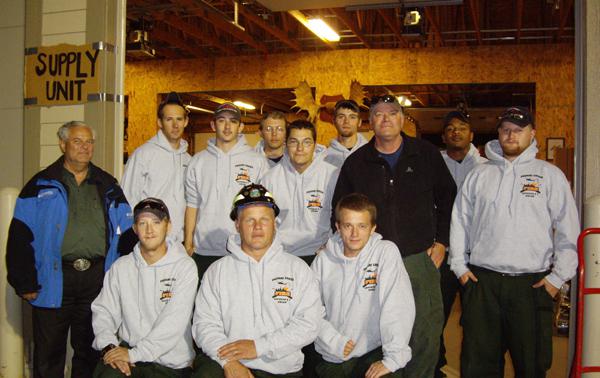
The Mingo Job Corp Fire Team served two weeks assisting the firefighters at the Pagami Creek fire in Minnesota. Team members include (front row, from left0 Vinna Godina, Crew Leader Bob Waldner, and Tyler D. Fugute; (back row) Benjamin Hauck, Receiving & Distribution Manager; and James D. Homilton, Justin A. Beller, Eric M. Crader, Ada T. Ritter, Patrick J. Brooks, Jordan M. Green, Christopher W. Maltby. (Photo courtesy of SMT Reader Bob Waldner)
By Tyler D. Fugate, Mingo Crew #1 Member
On Sept. 14, 2011, while in Syracuse, New York, aiding FEMA in the aftermath of Hurricane Irene, the Mingo Job Corps Fire Team, got a call to report to the Pagami Creek Fire, 13 miles east of Ely, Minn.
The crew was up at 4:30 a.m., the next day ready to fly out. After a flight of several hours, the crew was in Duluth, Minn., where we spent the night.
The next morning the crew got up and headed for Ely, which was about a 3-hour drive. Once there, the unit was attached to the Supply Unit led by Tim Bon, Ben and Dave.
The incident was led by the North Rockies Incident Management Team.
The Pagami Creek Fire was started by a lightning strike and ended up burning of 16 miles in just five days. It is the largest fire to occur in Minnesota since 1918.
Crews from 30 states came to serve and protect the Boundary Waters Canoe Area Wilderness and the surrounding towns. The BWCAW is the most visited National Forest in the U.S.
The Mingo crew was responsible for supplying 877 incident personnel, include 10 (Typle 1) Hotshot Crews, 12, Type 2 crews and three camp crews.
In addition, the Mingo personnel served two Type I helicopters, two type 3 helicopters, two scoopers (also known as waterbombers), two air attack planes three Beaver. On the southern end of the fire there were 18 fire engines, six dozers, and two water tenders.
The crew worked for 15 hours a days for 21 days straight. They worked with ground suppliers and air operators to deliver supplies to all the crews.
Air operation came into play to the supplies had to be slung – or flown in – by helicopters using leadlines and 3,000 pound cargo nets.
The Mingo crew exceeded expectations of the Northern Rockies team. The local team was praised for its work, because without supllies the more than 800 firefighters could not have done their job.

